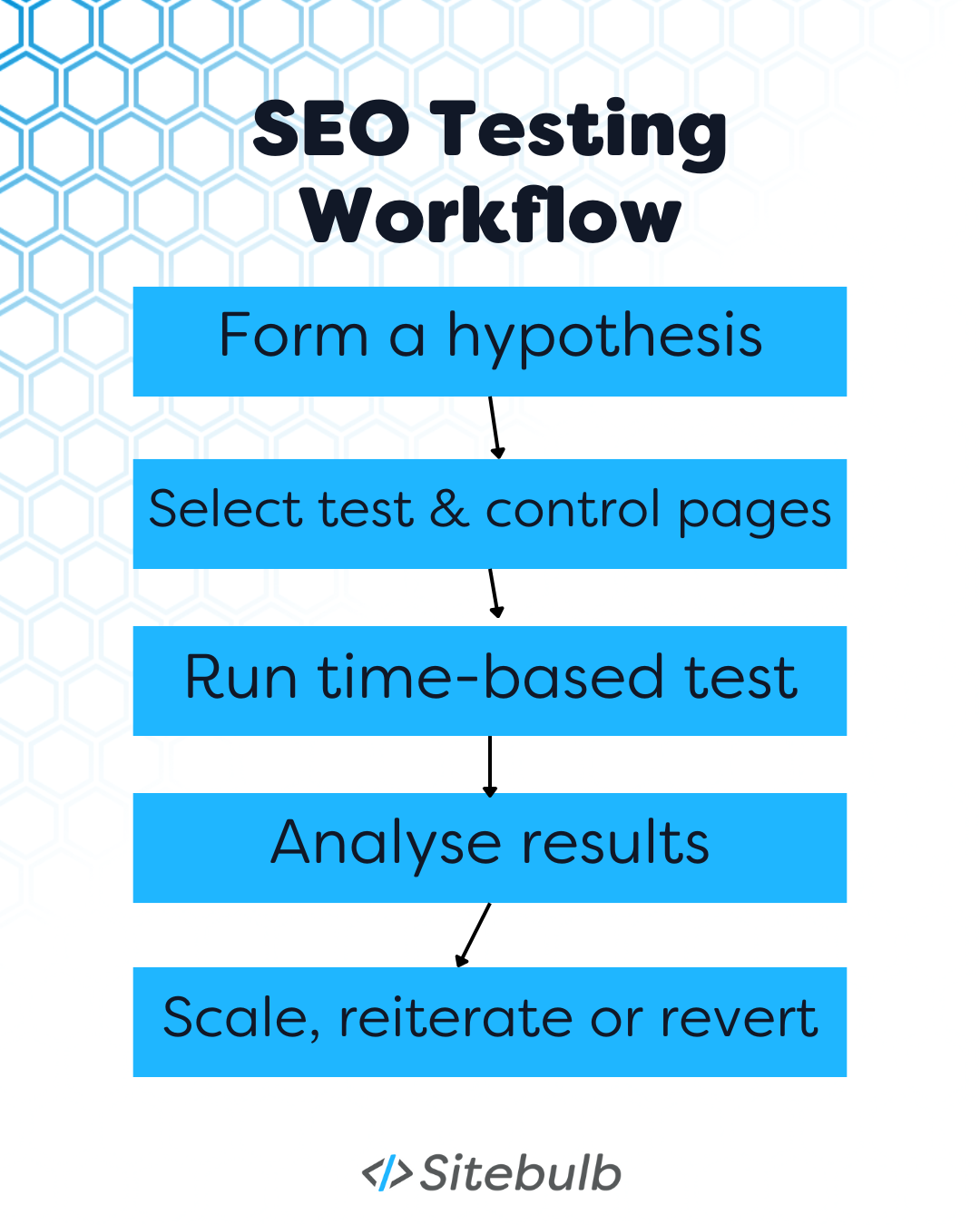
SEO Testing with Low Traffic: How to Make Smart Calls on Small Sites
Published July 28, 2025
This article was written by Sitebulb's Jojo Furnival but takes its inspiration from our recent SEO Testing Workshop with Giulia Panozzo. So, massive thanks to her!
If you're working on a small site with modest traffic, you've probably heard that "real" SEO testing is only for the big players with enterprise tools and millions of pageviews. But that's just not true.
You don't need a giant site or a six-figure tech stack to make smart, data-informed decisions. You just need a strategy that fits your scale—and the right mindset.
In a Sitebulb webinar packed with insight (and 90s nostalgia), Giulia Panozzo – neuroscientist-turned-SEO – shared her proven approach to SEO testing on small sites. Here's how you can make SEO testing work for you, even with limited traffic and zero budget.
Contents:
Why SEO testing isn’t just for big sites
Giulia’s career in SEO started with zero budget for testing, so she’s had to learn how to experiment the scrappy way. Working in-house and as a consultant, she found herself needing answers—but without the expensive platforms that typically support testing.

“I’ve been part of teams where testing is not really prioritised in the budget… So I had to do a lot of it on my own, learning to use free tools.”
Her message? You can absolutely test without fancy tools. Begin with what’s manageable. Use the tools you have. And build from there with confidence.
Use time-based testing when you don’t have enough pages for A/B tests
Time-based (or "pre-post") testing is perfect for smaller sites.
For example, if you update the H1 tag on a group of product listing pages to include more descriptive language, you can compare average clicks and impressions from the 28 days before the change to the 28 days after. This gives you a clear, directional view of whether the update had a positive or negative effect without needing to split test multiple variants at the same time.

“For small websites that have a bit less traffic, a time-based testing – so a pre-post test – might be more suited.”
It's not perfect – seasonality and external factors can muddy the results – but it's a solid alternative when A/B testing isn't viable. According to seotesting.com, many smaller teams rely on pre/post methods for validating changes in organic performance.

Avoid common mistakes when choosing pages to test
If your pages aren’t comparable, your test results won’t mean much. That’s why selecting the right test and control groups is one of the most important parts of the process.

“You want to select pages with enough traffic. Not only like two to three clicks a day. Not your outliers… and you want to compare pages of the same type.”
In other words: don’t compare product listing pages with blog posts, or homepage traffic with your checkout flow. Keep it consistent.
Free tools that make testing possible on a budget
Testing doesn't have to be expensive. Giulia walked through how to build a DIY testing stack with tools like:
Google Search Console: Use it to track impressions, clicks, and CTR across your pages. This is your core performance data source.
Search Analytics for Sheets: Extract GSC data directly into a Google Sheet for easy side-by-side comparisons across time periods.
Sitebulb: It’s not totally free but it does have a free trial, so you can crawl your site to identify technical issues and group similar page types for valid testing.
RStudio: Set up randomised test and control groups and run statistical models like Causal Impact.

“You can take a look at what might need improvement based on your technical audits. And that’s something that Sitebulb does really well.”
By combining free or freemium tools thoughtfully, you can form a comprehensive testing setup that punches above its weight.
How long should you run a test when you have limited traffic?
If your traffic is low, it’s tempting to run tests indefinitely to gather more data. But long durations introduce risk: external variables like algorithm updates, competitor changes, or seasonality can skew results.

“I normally recommend to give it at least two to four weeks to see a trend, with additional intermediate check-ins, just to catch if there’s something that goes extremely wrong.”
A two-to-four-week testing window with weekly check-ins is typically sufficient to observe meaningful trends while maintaining control.
Don’t just guess! Use Causal Impact to see the real results
Even without huge traffic numbers, you can bring confidence to your tests using Causal Impact, a time-series model developed by Google. It estimates what would have happened without your change by creating a “counterfactual” projection.
For example, after updating title tags on a group of category pages, Causal Impact can help you measure if the observed traffic increase is statistically significant or merely seasonal noise. To use it, download R Studio first (a free statistical computing platform) and then install the CausalImpact package to input your time series data.
According to Moz, using models like Causal Impact is increasingly common among advanced SEOs who want to back their decisions with stronger evidence.

“Causal impact is great, because it gives you the confidence to leverage statistically significant results and advocate for changes at scale.”
What to do when a test doesn’t work
Not every test delivers a win—and that’s okay. A “failed” test still provides clarity about what not to prioritise.

“If this doesn’t change and it’s still inconclusive or a loser, then it’s probably best to revert the change and focus on other tests.”
Document your findings, even when the results are inconclusive. Over time, these insights help you refine your hypotheses and avoid repeating ineffective tactics.
TL;DR: You don’t need big budgets to run smart tests
SEO testing doesn’t have to be exclusive to enterprise SEOs or data science teams. If you're just starting out, try running a simple pre-post test on meta title updates across a few category pages. Use Sitebulb to identify optimization opportunities, monitor the changes, and analyse the results with Google Search Console.
Start with a hypothesis—like whether updating your meta descriptions will improve click-through rate. Use Sitebulb to surface high-potential pages, gather your baseline with GSC, and use free tools to track impact.
According to a 2023 SparkToro report, only 29% of SEOs said they regularly test changes before rolling them out sitewide—so there's real opportunity in doing this well.
Your results don’t have to be perfect to be useful.

Jojo is Marketing Manager at Sitebulb. She has 15 years' experience in content and SEO, with 10 of those agency-side. Jojo works closely with the SEO community, collaborating on webinars, articles, and training content that helps to upskill SEOs.
When Jojo isn’t wrestling with content, you can find her trudging through fields with her King Charles Cavalier.
Articles for every stage in your SEO journey. Jump on board.
Related Articles
 SEO in 2026: 17 Expert Tips & Predictions
SEO in 2026: 17 Expert Tips & Predictions
 How to Stay Relevant in a World of AI Overviews & Query-Fans
How to Stay Relevant in a World of AI Overviews & Query-Fans
 Back to Basics: 3 SEO Pillars That Will Future-Proof Your Organic Growth
Back to Basics: 3 SEO Pillars That Will Future-Proof Your Organic Growth
 Sitebulb Desktop
Sitebulb Desktop
Find, fix and communicate technical issues with easy visuals, in-depth insights, & prioritized recommendations across 300+ SEO issues.
- Ideal for SEO professionals, consultants & marketing agencies.
Try our fully featured 14 day trial. No credit card required.
Try Sitebulb for free Sitebulb Cloud
Sitebulb Cloud
Get all the capability of Sitebulb Desktop, accessible via your web browser. Crawl at scale without project, crawl credit, or machine limits.
- Perfect for collaboration, remote teams & extreme scale.
If you’re using another cloud crawler, you will definitely save money with Sitebulb.
Explore Sitebulb Cloud Jojo Furnival
Jojo Furnival



